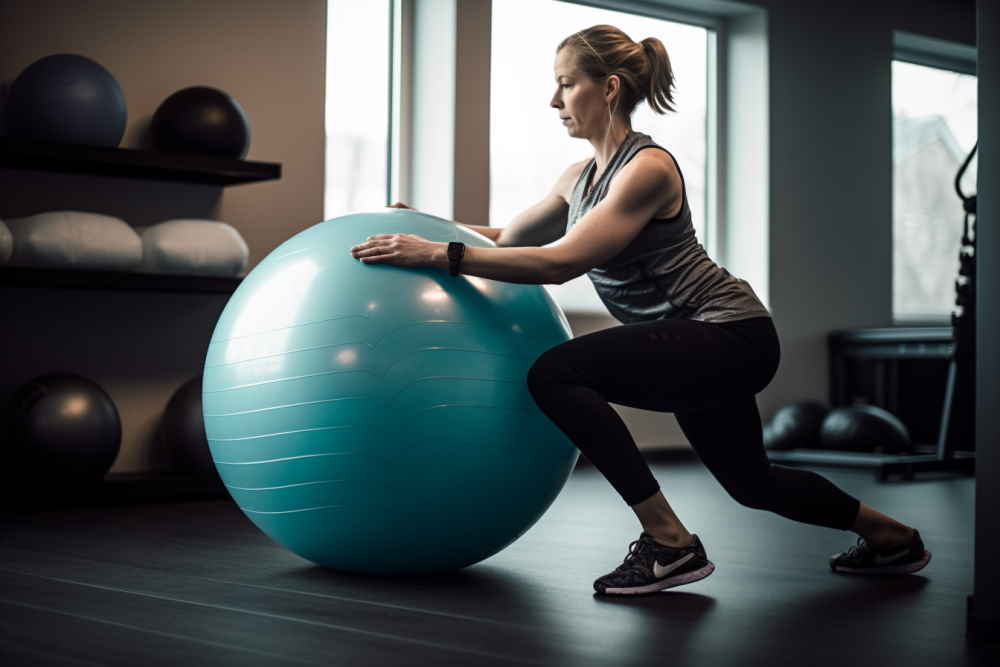Benefits of Using a Birthing Ball
Using a birthing ball during labor can provide numerous benefits, ranging from lower back pain relief to improved support and balance. Additionally, it may help alleviate stress and anxiety.Lower Back Pain Relief
One of the primary reasons many women utilize a birthing ball during labor is to lessen lower back pain. Sitting on the ball and gently rocking can help alleviate pressure on the back while providing a soothing rocking motion. According to WebMD, birthing balls have been shown to help reduce pain intensity during labor without causing any harm to the mother or baby.Support and Balance
As your body undergoes changes during pregnancy and labor, maintaining your balance and support can become more challenging. A birthing ball can help provide stability, making it easier to adopt and maintain more comfortable positions during labor. This extra support can be valuable when attempting to shift into an upright position, which is often preferable for encouraging the baby to move into a more favorable birthing position.Stress and Anxiety Reduction
During labor, it is common for women to experience heightened levels of stress and anxiety. Various birthing ball exercises can help you feel more in control of your childbirth experience, promoting a sense of calm and relaxation. Gently swaying, bouncing or rolling on the ball can be soothing and, according to Verywell Family, using movement with the birth ball can increase the benefits, helping to stretch your body and move the baby into a good position for birth.Choosing the Right Birthing Ball
Size and Height Considerations
To get the most benefit from a birthing ball, it’s essential to choose the right size based on your height. Birthing balls aren’t one size fits all, and they usually range in size from 55 cm to 75 cm. Here are some general guidelines for selecting the appropriate size for your height:- What size birthing ball do I need 5’2? If your height is 5’0″ to 5’5″, choose a 55 cm ball
- If your height is 5’6″ to 5’11”, choose a 65 cm ball
- If your height is 6’0″ or taller, choose a 75 cm ball
Material and Safety
Birthing balls are made of PVC material and designed to be non-slip and burst-resistant for safety during pregnancy and labor. When selecting a birthing ball, look for one that is made of a non-skid material and covered with a non-slip material to prevent accidents(WebMD). Additionally, ensure the ball has a weight capacity suitable for your needs, as a high-quality birthing ball should be able to support at least 200lbs of pressure. Finally, be sure to select a birthing ball that comes with a high-quality air pump to maintain the proper inflation level for ease of use and safety.How to Use a Birthing Ball During Pregnancy
Sitting and Posture
When using a birthing ball during pregnancy, proper sitting and posture are essential. First, ensure the ball is the correct size for your height. Sit on the ball with your feet flat on the floor and your knees bent at a 90-degree angle. Keep your back straight and engage your core muscles for stability. Place your hands on your knees or rest them on your hips to maintain balance. Sitting on the birthing ball like this can help strengthen your pelvic and abdominal muscles, prepare your body for labor, and improve your posture.Pregnancy Exercises
There are a variety of exercises you can perform with a birthing ball during pregnancy to help prepare your body for labor. The following exercises can be beneficial:- Pelvic Rock: Sit on the ball and gently rock your pelvis side to side.
- Pelvic Circle: Sit on the ball and make small circular movements with your pelvis.
- Lean Over Rock: Place a pillow on the floor, kneel on it, and lean forward to hug the birthing ball. Gently rock side to side to alleviate lower back tension.
- Bounces: Sit on the ball and gently bounce up and down, engaging your core muscles and maintaining your balance.
Birthing Ball Positions to induce Labor
How to use a birthing ball to induce labor
Rocking and Bouncing
Using a birthing ball during labor can provide gentle movements that help both you and your baby find the most comfortable positions. Rocking back and forth or bouncing gently on the ball can aid in relaxing your muscles and calming your nerves. This rhythmic motion encourages your baby to find an optimal position for birth.Leaning and Squatting
Another way to use a birthing ball is to lean on it while squatting. Place the ball against a wall, and lean your lower back on it while opening your legs and squatting down. This position can help stretch your lower back and provide support as you move into a deeper squat. Be sure to concentrate on your breathing and steadying yourself throughout the process.Upright Position
Maintaining an upright position with the support of a birthing ball can help balance your pelvis and guide your baby deeper into the pelvic cavity. Sitting on the ball and swaying your hips can alleviate pressure on your back while promoting optimal fetal positioning. Your doula or birth partner can also provide additional back massages and support while you are using the ball.Figures 8s
Performing figure 8s on a birthing ball is another helpful technique during labor. Sit on the ball and move your hips in a figure 8 motion, which helps stretch your hips and encourage your baby’s head to descend into the pelvis. This movement can also put pressure on the cervix, promoting dilation. Remember to change directions periodically and do these circles for about 10 minutes at a time.Pelvic and Cervical Effects
Using a birthing ball during labor can have significant effects on both your pelvis and cervix. By understanding how the birthing ball works for these areas, you can make better use of it to facilitate your labor process.Pelvis Opening and Alignment
As you sit and move on the birthing ball, it helps to open up and align your pelvis. This is crucial for providing space for your baby to descend and engage in the optimal fetal position. According to The VBAC Link, using a birthing ball encourages a more upright position, creating balance in the pelvis and allowing the baby to engage for a more optimal fetal position. Additionally, the movement and gentle bouncing on the ball can help promote movement of your baby deeper into the pelvis, as mentioned by Motherly.Cervix Dilation and Effacement
The use of a birthing ball during labor can also contribute to cervix dilation and effacement. As your baby moves deeper into your pelvis, there is increased pressure on your cervix, which helps to stimulate dilation and effacement (Birth Ball for Pregnant Women in Labour research protocol). Moreover, the rocking and swaying movements you perform on the birthing ball can help relax the pelvic muscles and may even contribute to a shorter labor. Remember to consult with your healthcare provider, birth partner, or doula as you practice using a birthing ball, and make sure to choose one of the appropriate size and quality for your specific needs. Throughout the process, listen to your body and take breaks as necessary, keeping in mind that a comfortable, relaxed, and open pelvis can help improve your birthing experience.Peanut Ball vs Birthing Ball
Both birthing balls and peanut balls are helpful tools during labor, but they differ in shape, benefits, and usage. In this section, we will explore these differences to help you make an informed decision about which one to use during your labor.Understanding the Differences
Regular birthing balls are round, exercise balls commonly used to provide comfort and support in various positions during labor. On the other hand, peanut balls are larger at the ends with a narrower middle, resembling a peanut shape. Birthing balls are versatile and can be used throughout your pregnancy as well as postpartum for exercise and relaxation. Peanut balls are more specialized tools for labor, particularly beneficial for those who have an epidural or are restricted to bed.Benefits and Usage for Each
- Birthing Ball
- Peanut Ball
Can Using a Birthing Ball Help Ease a Baby into the Butt-in-the-Air Sleeping Position?
Using a birthing ball can help ease a baby into the butt-in-the-air sleeping position. This position is believed to help with digestion and comfort for the baby. However, the science behind baby sleep suggests that the most important factor is creating a safe and comfortable sleep environment for the baby.


